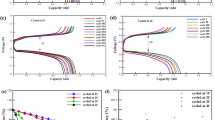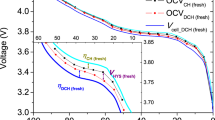Abstract
A 3.0 Ah pouch-type lithium-ion cell with a high energy density (200 Wh kg−1) was studied to establish a cycle life model of the battery. The cells consisted of graphite and LiNi0.6Co0.2Mn0.2O2 electrodes, and they were cycled at 1 C over a 100 % depth of discharge at different temperatures (25, 35, and 45 °C). A semi-empirical cycle life model was developed using experimental data by adopting a simple time power law and Arrhenius kinetics. The cycle life model agreed well with the experimental data but featured a much higher power law factor (1.3) compared to the value of 0.5 associated with the general t 1/2 rule based on the rate of solid electrolyte interphase (SEI) growth. The capacity fading mechanisms that operated within the cells were investigated using electrochemical, physical, and chemical diagnostic methods. These results revealed that the loss of active lithium ions via SEI formation as well as electrode degradation, especially cathode degradation, was responsible for the capacity fading in the cells.








Similar content being viewed by others
References
Honkura K, Takahashi K, Horiba T (2011) Capacity-fading prediction of lithium-ion batteries based on discharge curves analysis. J Power Sour 196:10141–10147
Peled E (1979) Electrochemical behavior of alkali and alkaline earth metals in nonaqueous battery systems—the solid electrolyte interphase model. J Electrochem Soc 126:2047–2051
Bloom I, Cole BW, Sohn JJ, Jones SA, Polzin EG, Battaglia VS, Henriksen GL, Motloch C, Richardson R, Unkelhaeuser T, Ingersoll D, Case HL (2001) An accelerated calendar and cycle life study of Li-ion cells. J Power Sour 101:238–247
Ramadass P, Haran B, White R, Popov BN (2002) Capacity fade of Sony 18650 cells cycled at elevated temperatures: part II. Capacity fade analysis. J Power Sour 112:614–620
Wang J, Liu P, Hicks-Garner J, Sherman E, Soukiazian S, Verbrugge M, Tataria H, Musser J, Finamore P (2011) Cycle-life model for graphite-LiFePO4 cells. J Power Sour 196:3942–3948
Gu W, Sun Z, Wei X, Dai H (2014) A capacity fading model of lithium-ion battery cycle life based on the kinetics of side reactions for electric vehicle applications. Electrochim Acta 133:107–116
Broussely M, Herreyre S, Biensan P, Kasztejna P, Nechev K, Staniewicz RJ (2001) Aging mechanism in Li ion cells and calendar life predictions. J Power Sour 97–98:13–21
Ning G, White RE, Popov BN (2006) A generalized cycle life model of rechargeable Li-ion batteries. Electrochim Acta 51:2012–2022
Kim JH, Woo SC, Park MS, Kim KJ, Yim T, Kim JS, Kim YJ (2013) Capacity fading mechanism of LiFePO4-based lithium secondary batteries for stationary energy storage. J Power Sour 229:190–197
Liu P, Wang J, Hicks-Garner J, Sherman E, Soukiazian S, Verbrugge M, Tataria H, Musser J, Finamore P (2010) Aging mechanisms of LiFePO4 batteries deduced by electrochemical and structural analyses. J Electrochem Soc 157:A499–A507
Kostecki R, Lei J, McLarnon F, Shim J, Striebel K (2006) Diagnostic evaluation of detrimental phenomena in high-power lithium-ion batteries. J Electrochem Soc 153:A669–A672
Kim JH, Pieczonka NPW, Li Z, Wu Y, Harris S, Powell BR (2013) Understanding the capacity fading mechanism in LiNi0.5Mn1.5O4/graphite Li-ion batteries. Electrochim Acta 90:556–562
Zheng H, Sun Q, Liu G, Song X, Battaglia VS (2012) Correlation between dissolution behavior and electrochemical cycling performance for LiNi1/3Co1/3Mn1/3O2-based cells. J Power Sour 207:134–140
Kabitz S, Gerschler JB, Ecker M, Yurdagel Y, Emmermacher B, Andri D, Mitsch T, Sauer DU (2013) Cycle and calendar life study of a graphite|LiNi1/3Mn1/3Co1/3O2 Li-ion high energy system. Part A: full cell characterization. J Power Sour 239:572–583
Ecker M, Nieto N, Kabitz S, Schmalstieg J, Blanke H, Warnecke A, Sauer DU (2014) Calendar and cycle life study of Li(NiMnCo)O2-based 18650 lithium-ion batteries. J Power Sour 248:839–851
Spotnitz R (2003) Simulation of capacity fade in lithium-ion batteries. J Power Sour 113:72–80
Wright RB, Motloch CG, Belt JR, Christophersen JP, Ho CD, Richardson RA, Bloom I, Jones SA, Battaglia VS, Henriksen GL, Unkelhaeuser T, Ingersoll D, Case HL, Rogers SA, Sutula RA (2002) Calendar- and cycle-life studies of advanced technology development program generation 1 lithium-ion batteries. J Power Sour 110:445–470
Ning G, Haran B, Popov BN (2003) Capacity fade study of lithium-ion batteries cycled at high discharge rates. J Power Sour 117:160–169
Pinson MB, Bazant MZ (2013) Theory of SEI formation in rechargeable batteries: capacity fade, accelerated aging and lifetime prediction. J Electrochem Soc 160:A243–A250
Noh HJ, Youn S, Yoon CS, Sun YK (2013) Comparison of the structural and electrochemical properties of layered Li[NixCoyMnz]O2 (x = 1/3, 0.5, 0.6, 0.7, 0.8 and 0.85) cathode material for lithium-ion batteries. J Power Sour 233:121–130
Ohzuku T, Iwakoshi Y, Sawai K (1993) Formation of lithium-graphite intercalation compounds in nonaqueous electrolytes and their application as a negative electrode for a lithium ion (shuttlecock) cell. J Electrochem Soc 140:2490–2497
Wang J, Purewal J, Liu P, Hicks-Garner J, Soukazian S, Sherman E, Sorenson A, Vu L, Tataria H, Verbrugge MW (2014) Degradation of lithium ion batteries employing graphite negatives and nickel-cobalt-manganese oxide + spinel manganese oxide positives: part 1, aging mechanisms and life estimation. J Power Sour 269:937–948
Purewal J, Wang J, Graetz J, Soukiazian S, Tataria H, Verbrugge MW (2014) Degradation of lithium ion batteries employing graphite negatives and nickel-cobalt-manganese oxide + spinel manganese oxide positives: part 2, chemical-mechanical degradation model. J Power Sour 272:1154–1161
Acknowledgments
This work was supported by the secondary battery R&D program for leading green industry of MOTIE/KEIT (10041142, Electrolyte Additive for 200 Wh kg−1 High LIB of High Cycle Life).
Conflict of interest
The authors declare that they have no conflict of interest.
Author information
Authors and Affiliations
Corresponding author
Rights and permissions
About this article
Cite this article
Lee, YJ., Choi, HY., Ha, CW. et al. Cycle life modeling and the capacity fading mechanisms in a graphite/LiNi0.6Co0.2Mn0.2O2 cell. J Appl Electrochem 45, 419–426 (2015). https://doi.org/10.1007/s10800-015-0811-6
Received:
Accepted:
Published:
Issue Date:
DOI: https://doi.org/10.1007/s10800-015-0811-6




